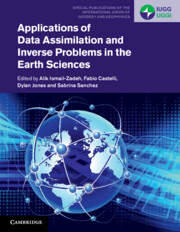Book contents
- Applications of Data Assimilation and Inverse Problems in the Earth Sciences
- Series page
- Applications of Data Assimilation and Inverse Problems in the Earth Sciences
- Copyright page
- Contents
- Contributors
- Preface
- Acknowledgements
- Part I Introduction
- Part II ‘Fluid’ Earth Applications: From the Surface to the Space
- 5 Data Assimilation of Seasonal Snow
- 6 Data Assimilation in Glaciology
- 7 Data Assimilation in Hydrological Sciences
- 8 Data Assimilation and Inverse Modelling of Atmospheric Trace Constituents
- 9 Data Assimilation of Volcanic Clouds: Recent Advances and Implications on Operational Forecasts
- 10 Data Assimilation in the Near-Earth Electron Radiation Environment
- Part III ‘Solid’ Earth Applications: From the Surface to the Core
- Index
- References
5 - Data Assimilation of Seasonal Snow
from Part II - ‘Fluid’ Earth Applications: From the Surface to the Space
Published online by Cambridge University Press: 20 June 2023
- Applications of Data Assimilation and Inverse Problems in the Earth Sciences
- Series page
- Applications of Data Assimilation and Inverse Problems in the Earth Sciences
- Copyright page
- Contents
- Contributors
- Preface
- Acknowledgements
- Part I Introduction
- Part II ‘Fluid’ Earth Applications: From the Surface to the Space
- 5 Data Assimilation of Seasonal Snow
- 6 Data Assimilation in Glaciology
- 7 Data Assimilation in Hydrological Sciences
- 8 Data Assimilation and Inverse Modelling of Atmospheric Trace Constituents
- 9 Data Assimilation of Volcanic Clouds: Recent Advances and Implications on Operational Forecasts
- 10 Data Assimilation in the Near-Earth Electron Radiation Environment
- Part III ‘Solid’ Earth Applications: From the Surface to the Core
- Index
- References
Summary
Abstract: There is a fundamental need to understand and improve the errors and uncertainties associated with estimates of seasonal snow analysis and prediction. Over the past few decades, snow cover remote sensing techniques have increased in accuracy, but the retrieval of spatially and temporally continuous estimates of snow depth or snow water equivalent remains challenging tasks. Model-based snow estimates often bear significant uncertainties due to model structure and error-prone forcing data and parameter estimates. A potential method to overcome model and observational shortcomings is data assimilation. Data assimilation leverages the information content in both observations and models while minimising inherent limitations that result from uncertainty. This chapter reviews current snow models, snow remote sensing methods, and data assimilation techniques that can reduce uncertainties in the characterisation of seasonal snow.
Keywords
- Type
- Chapter
- Information
- Publisher: Cambridge University PressPrint publication year: 2023

